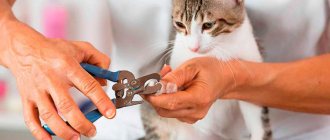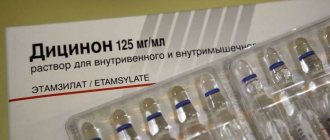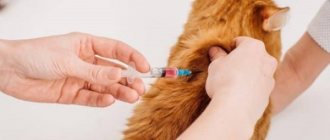Castration of cats is a procedure that eliminates libido and corrects the behavioral manifestations of the animal’s sexual activity. As a result of the removal of the testes, reproductive function is irreversibly stopped, and the production of the male hormone testosterone also stops, which affects behavior. The main reasons for castration are difficulties in keeping cats after they reach puberty, as well as medical indications.
Cat in a protective collar after castration
Methods
In veterinary practice, various methods of castration of cats are used. Each of them has its own characteristics, advantages, optimal age and possible undesirable consequences. Before deciding to choose a castration method, you should consult with a veterinarian, who will determine which is best, taking into account the age and condition of the cat. Currently, the following types of procedures are used in veterinary medicine.
Chemical
Castration involves the regular administration of medications that suppress estrus. Chemical castration of cats is a reversible procedure: after some time after stopping the use of drugs, sexual function and the ability to reproduce are restored.
Surgical
The surgical method is used most often in veterinary practice. The technique is as follows: the scrotum is cut, the spermatic cords are tied up, the testes are cut off and taken out. Surgical castration is performed under anesthesia; the recovery period lasts until the cat’s wound heals.
Mechanical
Bloodless (or mechanical) sterilization of a cat involves squeezing the vas deferens with veterinary forceps. As a result, the ducts atrophy and dissolve over time. The bloodless method is irreversible. Its advantages include low cost and short rehabilitation.
Radial
The essence of the method is to expose the testes of cats to certain doses of radiation. After castration by irradiation, a cat's eggs stop producing hormones and viable sperm. Radiation sterilization has many disadvantages: after irradiation, the risk of developing inflammatory processes and the formation of malignant tumors increases significantly.
Hormonal
This is the name of medical castration using hormonal drugs. The introduction of hormones of the opposite sex temporarily suppresses sexual function. The procedure is considered reversible. Chemical and hormonal castration does not require preliminary preparation and long-term rehabilitation of the cat.
Vasectomy
The operation involves ligating the vas deferens. The cat loses the ability to reproduce, but the ability to mate and sexual reactions are fully preserved. Vasectomy is a complex operation; the recovery period after it lasts about two weeks.
Anatomical data
The scrotum is a bag of skin, muscles and other tissues. The outer layer of the “bag” is represented by the dermis, the inner layer by the muscular-elastic layer and fascia. The top of the scrotum is covered with thin, small hairs; the dermis contains sweat and sebaceous glands. The muscular-elastic membrane divides the scrotum into left and right halves through the median septum.
The external levator testis grows into the outer layer of the common tunica vaginalis and is isolated from the scrotum by the levator fascia. Therefore, when the sac is cut during castration, the common tunica vaginalis, together with the external levator, is very easily detached.
The common tunica vaginalis is created by two fused sheets:
- The outer fibrous sheet is attached to the scrotum through its fascia.
- The inner serous leaf is attached to the epididymis by means of a transitional ligament.
Thus, a cavity of the common vaginal membrane is formed between the testis and the scrotum. The area that covers the inguinal canal is called the parietal vaginal canal. In all mammals, the cavity of the common tunica vaginalis has access to the abdominal cavity through the vaginal canal.
The inguinal canal is an opening in the groin area near the pubic bone, midway between the external and internal oblique muscles. It contains the external levator, external pudendal arteries and veins, the external spermatic nerve and the vaginal canal.
The inguinal canal originates from the abdominal internal ring-opening and ends with the external subcutaneous opening. The external inguinal ring is located in the tendon plate of the external oblique muscle between its abdominal and pelvic plates. The internal abdominal ring is located near the pubic bone, it borders cranially with the pelvic part of the internal oblique muscle, and caudally borders with the inguinal ligament.
A pair of testes with appendages is located in the cavity of the common vaginal membrane. They distinguish between head (lower) ends and tail (upper) ends. At the lower end there is the testis itself and the head of the epididymis, the upper end is formed by the tail of the epididymis.
The spermatic cord is formed by the fold of the internal mesentery of the testis; it contains vessels, nerves, the internal levator of the testis and the vas deferens. In the anterior part, the cord creates a vascular weave. The scrotum in cats is located between the thighs closer to the anus behind the ischial bones.
Complexity of the procedure
Surgical removal of the testes is not a complex operation. If the cat was properly prepared for the procedure, all manipulations were carried out by a qualified specialist in compliance with the technique, complications after castration are minimal or absent.
Young cats tolerate castration well and, with proper care, recover fairly quickly. Castration of an adult cat may be associated with certain risks: the difficulty lies in the fact that older males and those suffering from heart disease may experience complications from the cardiovascular system during the operation. In this regard, local anesthesia is recommended for such animals.
Surgical castration
Before the operation, the animal is brought to the clinic in advance, the doctor is told about chronic diseases, previous operations, and contraindications to anesthesia are excluded. Blood is taken from the cat for biochemical analysis to identify hidden pathologies. Additionally, representatives of breeds predisposed to hypertrophic cardiomyopathy are examined: Maine Coons, Sphynxes, British cats, Scottish folds, bobtails.
Preparing for surgery
On the day of castration, the veterinarian examines the cat: measures temperature, pulse, blood pressure, feels the stomach and lymph nodes, and checks the mucous membranes of the mouth. Based on the results of the visual examination, he recommends an ultrasound of the heart, abdominal organs, and an electrocardiogram.
A veterinary surgeon prepares instruments:
- injection syringes;
- abdominal scalpel;
- tweezers;
- clamps;
- tampons;
- surgical needles;
- needle holder;
- surgical scissors;
Instruments are sterilized in an alkali solution for a quarter of an hour.
Anesthesia
Cats are castrated under general anesthesia, their muscles relax, sensitivity to pain disappears, and consciousness turns off.
Drugs are administered using the following methods:
- Parenteral. Medicines are given intravenously or intramuscularly. In the first case, the operation begins after 2 minutes; if the dose is calculated correctly, the effect lasts 15–20 minutes. This time is enough for the operation; the anesthetic does not have time to deeply affect the respiratory and cardiovascular systems. When administered intramuscularly, the effect of the drug begins after 5–10 minutes, the recovery after anesthesia lasts longer. This method is used for excitable animals.
- Inhalation . Narcotic gas is supplied to the lungs through an endotracheal tube or mask, it penetrates into the blood and causes deep anesthesia. After the procedure, the gas is eliminated through the lungs, and the liver eliminates the remaining gas. This method is safer, but more expensive. The equipment is found only in large clinics.
Local anesthesia for castration of cats is rarely used. The animal is first immobilized, then the incision site is injected with analgesics.
Progress of the operation
The procedure consists of three stages:
- Preparation of the surgical field . Doctors shave or pluck the hair on the scrotum, wash it in a soapy solution to remove fatty secretions, and treat it with antiseptics: iodine or ethyl alcohol.
- Removal of testes . The skin is cut with a scalpel, the testis is separated from the vaginal membrane, and it is removed from the incision. To stop bleeding, two methods are used: divide the spermatic cord into 2 parts and tie it into biological nodes or apply a ligature or surgical thread. Then the testis and part of the cord are cut off.
- Treatment of the wound . The incision site is disinfected with an antiseptic, but is not sutured so that the inflammatory exudate can drain freely.
After the operation, the doctor measures your blood pressure, listens to your heartbeat, and if he finds no abnormalities, he sends you home. Owners are advised to stay in the clinic for 20 minutes, observe the animal, and return to the doctor in case of bleeding or other problems.
Points for and against
Many cat owners are wondering: is it necessary to castrate a pet and how justified is castration from a physical and moral point of view? In the natural habitat after puberty, the main purpose of a male’s life is reproduction. Domestic cats walking outside have their own territory, which must be regularly marked and defended. The result of contractions is injury and stress, and constant contact with street animals poses an increased risk of contracting infections and parasites. Neutered cats do not pose a danger to other males and do not participate in fights.
Do animals that do not go outside need sterilization, because in this case the possibility of contact with street cats is excluded? A domestic adult cat without castration will constantly look for a female to realize the reproductive instinct. If he yells, doesn't eat, doesn't sleep well, constantly marks corners, becomes aggressive and ruins things, this could be the first sign that he wants a cat. Does castration help cope with this behavior of a pet? A castrated cat stops marking, and changes in behavior will also occur: the animal’s character will become more docile. What other arguments are there for and against intervention?
pros
Those who are unsure whether to undergo surgery on their pet should evaluate the pros and cons of castration of cats. The positive aspects of the intervention include a beneficial effect on the psychological and physical condition of cats. The advantages of castration of a cat are that the operated males live longer, and they do not have problems with the prostate.
Minuses
So should the cat have surgery? There aren't many negative points. These include possible complications, the risk of which exists with any surgical intervention.
Age for castration surgery
Whether it is worth castrating a cat is, of course, a matter for each owner. Many argue that after the castration procedure the cat’s life will improve significantly, while others confidently believe that it can cause severe harm to the animal. But in any case, you need to know when it is better to castrate a cat.
It is age that is considered important for this procedure. In this case, the breed of the animal does not matter at all. A British cat, a Maine Coon cat and a domestic cat are neutered at almost the same age.
So, when is a cat neutered? Let's consider several important nuances that will help give an accurate answer to this question:
- many veterinary experts claim that the appropriate age for a cat to castrate is when the pet is under one year old;
- What time is this procedure done? It is better to carry it out when the cat is already 7-9 months old. At this time, he is considered an adult, he has already begun puberty, but it is in the active phase and has not yet reached the final stage;
- as soon as the process of puberty is completed, the production of sex hormones will be observed not only in the testicles, but also in the pituitary gland;
- When the testicles are removed at an early age, the signal from them is not sent to the pituitary gland, which means that they will be released in a small volume.
But you should not castrate at too early an age, because this can negatively affect the health of the animal. This often provokes a serious complication – urethral stricture.
It is worth noting! In kittens at too young an age, the urinary canal has a narrow structure, and even a slight inflammatory process (and it necessarily occurs during castration) causes the appearance of adhesions and blockage of the ureter.
For this reason, if you are wondering when to castrate a British or ordinary purebred cat, then veterinarians will confidently say that the cat must be at least 7 months old . You should not carry out this procedure too late, when the animal’s sexual formation is completed, otherwise the surgical intervention will not be able to bring the desired effect.
Common Myths
- Myth 1. The cat will stop marking immediately after the procedure.
In fact, everything is individual, and whether a cat will stop marking after castration depends on the timing of removal of the testes. If the procedure is carried out at puberty, then the change in the cat’s hormonal levels will take some time. It happens that a cat shits after castration, thus marking its territory due to the lack of a secret. About 5% of males do not stop leaving marks at all. This problem occurs in those cats that have already been in contact with females: their hormones are produced not only in the testes. That is why it is impossible to unequivocally answer the question of whether an adult pet will mark after castration. To prevent domestic cats from marking, the operation should be performed at a young age.
- Myth 2. Neutered cats have a bad character.
Cases where a cat becomes aggressive after removal of the testes are quite rare. Animals, on the contrary, calm down and become more affectionate and tame. Males behave aggressively after castration has been carried out only due to deterioration of their condition or the appearance of any irritating factors.
- Myth 3. Castration causes cats to get fat.
Weight gain can be caused by poor diet or eating too large portions. Typically, a neutered cat will look the same as before surgery if feeding is adjusted to account for the reduction in energy expenditure.
- Myth 4. A castrated cat does not catch mice.
Many people are concerned about the question: can cats hunt after castration? In this regard, the animal continues to lead the same lifestyle as before.
These and other common myths about castration have nothing to do with reality and should not influence the decision of a cat owner.
At what age should I do it?
When can a cat be neutered? The optimal time recommended by experts is 3-4 weeks before puberty. So at what age is it better to castrate a cat? It all depends on the breed: Abyssinians, Burmese and other oriental breeds mature earlier - by 5 months, other cats reach the optimal age by 7-8 months.
Castration too early is undesirable for the reason that before the onset of puberty, the genitourinary system of cats is still developing.
Contraindications for carrying out
Castration is performed under general or local anesthesia. Not all cats are able to tolerate anesthesia due to age, the presence of certain diseases, or allergies to medications. The first thing you need to know before the procedure is whether your pet has an allergic reaction to the drugs and whether his heart is able to function normally during the procedure. To establish possible contraindications for the intervention, the cat must first be examined by a veterinarian. Permission is given after analyzing the results obtained.
Preoperative period
In order for castration to take place without complications, the pet must be properly prepared. You need to start with a visit to the veterinarian. He will examine the animal, prescribe additional examinations if necessary (ultrasound of the heart, blood and urine tests), and tell you how to prepare the cat for removal of the testes. Typically, preparing a cat for castration involves following a special feeding and drinking regimen. In each specific case, the preoperative period may differ slightly.
Preparation for the procedure
What should you do before the operation? 12 hours before the scheduled visit to the clinic, you must stop giving the animal food. Feeding a cat before surgery is not recommended due to the fact that anesthesia causes a gag reflex, and the animal may choke on vomit. They stop giving him water 3 hours before the planned castration. In some cases, it is necessary to give a cat a laxative before castration. There is no need to wash or clip the animal.
Advantages and disadvantages of castration
Carrying out surgical intervention is not an empty desire of the owner to turn a pet mustache into a soft toy. Such interference in the body has positive and negative sides. Among the advantages of removing the gonads are:
- Reducing manifestations of aggression on the part of the pet. During the period of searching for a female, he becomes conflicted, nervous, and may attack or hiss at a person. After excision of the testes, there will be no need for sexual hunting, and aggression will be reduced to a minimum.
- Reducing unpleasant physical behavior, such as obsessive loud meowing to attract a partner. The cat will not have the need to mark its territory.
- There will be no attempts to escape from home and go on a long journey. The pet will now stay at home or in a well-known yard with great pleasure. He won't want to go out looking for a bride.
- Prevention of urological diseases. Thus, males, thanks to the removal of the gonads, are completely free from testicular cancer or prostate adenoma.
Owners of male cats need to understand that castration of a cat at any time is not a panacea for all health or behavioral problems. Each surgical intervention involves a number of difficulties:
- metabolic disorders and the development of obesity;
- impossibility of using a male for mating;
- probable complications in the form of the development of urolithiasis.
In fact, there are few hassles after the process, and some of them are easy to deal with. To avoid problems with digestion and salt deposition, it is enough to reduce and adjust the animal’s diet.
How does the intervention work?
Many owners worry that the cat experiences pain and discomfort during the procedure. In fact, the only unpleasant moment is the injection of an anesthetic drug. Regardless of how cats are castrated (under general or local anesthesia), they do not feel pain.
As soon as the anesthesia takes effect, the doctor proceeds directly to the manipulation. How this happens depends on the type of procedure chosen. Typically, the testes are removed through two small incisions in the scrotum, after ligating the spermatic cords. At the end of the procedure, the veterinarian will give detailed instructions on how to care for the cat after castration.
More details about the operation
There are two types of surgery performed on cats:
- Removal of testicles. The animal is put under anesthesia, after which the surgeon cuts the scrotum and ties the spermatic cord so that there is no loss of blood. Then the testis is cut off with scissors, after which the scrotum is sutured. As a result of the operation, the cat's hormonal levels change and he becomes infertile.
- Vasectomy. In this surgical procedure, the testes remain and continue to function, but the spermatic cord is cut or ligated, which prevents sperm from entering the spermatic duct. The hormonal levels do not change, the cat continues to mark corners and demand a cat, but he can no longer have children.
Postoperative period
To quickly restore the cat and prevent complications, it is necessary to follow all the specialist’s recommendations in the two-week period after the intervention. Features of care on the first day depend on how long the anesthesia wears off after castration of the cat. Animals that require castration under general anesthesia require the most attention.
Post-operative care
Upon returning from the clinic, the cat should be placed on a bedding and covered, since as a result of the administration of painkillers, natural thermoregulation is disrupted. Every 20-30 minutes it must be turned over on one side or the other, which will make it possible to prevent numbness and muscle spasms. As cats recover from anesthesia, they may experience unsteadiness on their paws, a staggering gait, and blurred vision. After castration, a cat may behave somewhat strangely: hide, not make contact, or be restless and overly active. During the first few days after castration, this behavior is within normal limits.
If the cat starts to get up, you need to place a tray nearby so that he doesn’t have to go far. Sometimes 1-2 times after surgery, a disoriented animal may wander past the tray or diaper. In this case, you should not scold the cat, since these are just consequences of the operation.
If your cat licks stitches too often or suffers from oral diseases, a special collar may be required in the postoperative period. It will prevent infection and suture dehiscence. How long to wear a collar? The timing is determined by the veterinarian depending on how long the wound takes to heal. It is recommended to bathe the animal no earlier than 2 months after the procedure. If necessary, contaminated areas can be wiped with a damp, well-wrung out sponge.
Proper care in the first days is very important, since the successful outcome of the procedure largely depends on it.
How long does it take to recover from anesthesia?
To correctly assess your pet’s condition, you should know how long it takes for cats to recover from anesthesia. It all depends on the method of pain relief, the characteristics of the body, the drug and the correct calculation of the administered dose.
So, how long does it take for a cat to recover from anesthesia after castration? Sleep usually lasts from 30-40 minutes to 4-5 hours. If a castrated cat does not come to his senses for a long time, you should periodically check his reactions: touch his nose, paws, ears. The cat's attempts to pull his paw or move his ear indicate that there is no reason to worry.
Feeding
Caring for a cat after castration includes a certain drinking and feeding regimen. As soon as the animal wakes up, it needs to moisten its larynx. To do this, a small amount of liquid is poured into the cat’s mouth in small portions, since the swallowing reflex is not restored immediately. A bowl of water is placed when the cat has completely recovered from the effects of the drugs.
Feeding a cat is carried out only if the animal itself shows interest in food. You shouldn't do this by force. Portions should be small, and the volume of food the cat should be increased gradually.
What to feed
What to feed a cat after castration? In the first days, it is worth giving light food: meat or fish puree, dry food pre-soaked in water.
After how long
How long after castration can you feed a cat? Typically, 7-8 hours are enough to recover from anesthesia. You can give food to your cat no earlier than this period.
Complications
All possible complications of castration are divided into those that occur immediately after the procedure and later ones that appear during the healing process. In the first hours after the cat has undergone surgery, it is necessary to monitor its condition. If swelling, wheezing, or a sudden change in temperature or color of the mucous membranes occurs, you should immediately seek medical help. A cat’s poor reaction to anesthesia can result in death if not intervened in a timely manner.
The most common postoperative complications in cats include swelling and hematomas. In such cases, the animal does not go to the toilet for a long time, licks the enlarged scrotum, and shows anxiety. As a rule, blood or lymph that has accumulated in and around the scrotum dissolves on its own after some time.
Castration can cause more dangerous complications in cats: infection of the sutures (accompanied by fever and purulent discharge), damage to the urethra (the cat's urine will contain blood), bleeding and hemorrhages. In order for castration to take place without complications, it is necessary to properly care for your pet and trust it only to a proven, qualified specialist.
How long does it take for a wound to heal after castration? With standard castration, a period of 7 to 10 days is considered the norm.
Caring for an animal after castration. Possible complications
The patient must stay in the veterinary clinic for the first hours. During this period, the doctor will be able to make sure that the cat tolerated the anesthesia normally. In the first postoperative hours, the following manifestations will be observed in your pet:
- dizziness;
- nausea;
- feeling of thirst;
- muscle weakness;
- dry eyes;
- low body temperature;
- unsteadiness of gait.
The pet can remain under the supervision of a veterinarian for the first 24 hours, but this will put him in a stressful state. Experienced doctors recommend taking the cat home. The pet needs attention and care, as well as painkillers. The groin area should be examined daily. To speed up the healing of the stitches, they are treated with peroxide and brilliant green.
To prevent the animal from licking the wound, you can wear a special collar that is removed when eating. Tetracycline ointment should be used for eye care. A warm heating pad will calm your furry friend and give him a feeling of comfort. Recovery after surgical procedures is easier in winter. In summer, you also need to take antibiotics.
At first, the cat's toilet should be bright so that the owner can notice the bleeding. You can wear a diaper with a hole for a tail. The first time after sterilization, animals experience a decreased appetite, then an increased one. You should give your cat enough water and monitor its diet. Your pet should not overeat.
Complications after surgery cannot be ruled out. The consequences of surgical manipulations are divided into:
- Early. Bleeding, prolapse of the spermatic cord, omentum, etc. are noted immediately.
- Late. Inflammatory and infectious pathologies develop gradually.
- Scrotal swelling and inflammation are often caused by poor sanitary and hygienic conditions. The most dangerous phenomenon is a retroperitoneal abscess. This is a secondary type of complication that occurs due to inflammation of the spermatic cord.
To avoid pathological processes, preference should be given to a proven and professional clinic.
Anesthesia
Regardless of the age and condition of the animal, anesthesia is required when castrating cats. Today, two types of anesthesia are used in veterinary practice: general and local.
General
Painless castration is often performed under general anesthesia. To euthanize the cat before castration, medications may be administered or inhalation anesthesia may be used. Gas euthanasia is more expensive, but has several important advantages: it has a minimum of side effects, the intensity of the gas supply is adjusted during the castration process, and removing the cat from anesthesia is easier and faster.
Local
Local anesthesia during castration is considered more gentle: it does not require long recovery and does not have such a negative effect on the cat’s body as general anesthesia. However, this method of pain relief is only suitable for calm cats.
Where to castrate
After the decision to sterilize the pet is finally made, the question arises: where to castrate the cat? Sterilization can be carried out both in the clinic and at home.
Vet clinic
A veterinary clinic is the best option, since if critical situations arise, the doctor will have all the necessary equipment at his disposal. Castration of a cat in the clinic is mandatory if there are liver and kidney diseases. You should not take risks in cases where the age of the male is more than 3-4 years. In addition, when contacting the clinic, data about the cat and all manipulations performed are entered into the medical record. The veterinary clinic also issues the cat owner a contract and a receipt confirming payment for services.
At home
Castration of a cat at home is associated with certain risks. If the owner decides to call a doctor at home, it is necessary to make sure that he is qualified and has a license to perform operations, including castration of cats. It is also important to provide conditions for performing the procedure. Castration at home is allowed at a young age and in the absence of health problems.
Castration of cats is a serious procedure that requires sufficient qualifications of a specialist and compliance with certain conditions before and after it. In each specific case, the veterinarian assesses the situation and gives individual recommendations on how best to castrate the animal and what kind of care to provide it.
Castration of cats
Castration of stallions
Dog castration











